We're celebrating our new website -
and you get. . .
and you get. . .
A special 10% Off!
Simply enter LAUNCH10 at checkout to redeem your discount. Don’t miss out on this limited time offer!
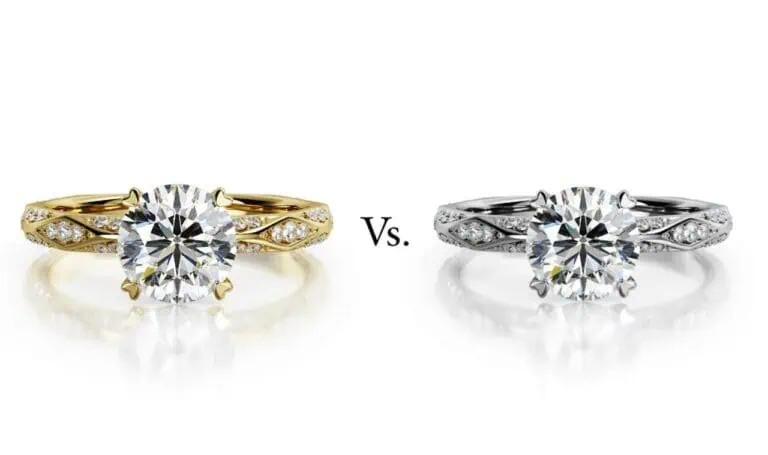
Diamonds have captivated hearts for centuries, symbolizing love, commitment, and everlasting brilliance. But when it comes to the setting, a crucial decision arises: white gold or yellow gold? Both metals beautifully complement diamonds, each offering a distinct aesthetic. This comprehensive guide delves into the world of white gold vs yellow gold, empowering you to choose the setting that perfectly complements your unique style and the brilliance of your diamond.
Delve into a world where the luster of gold meets the sparkle of diamonds, and explore our exquisite collections that capture this timeless dance of elegance.

White gold reigns supreme for those seeking a modern and elegant look. Its cool, silvery hue creates a stunning contrast against the diamond’s fire, making the stone appear brighter and whiter. This is because white gold is an alloy, meaning it’s a blend of pure gold with other metals like nickel and palladium. These additional metals give white gold its strength and distinctive color.
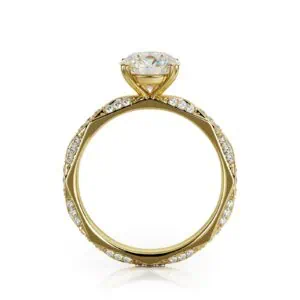
Yellow gold, a timeless classic, exudes warmth and sophistication. Its rich, honeyed hue beautifully complements the diamond’s natural fire, creating a classic and luxurious aesthetic. Yellow gold is a natural metal, requiring minimal alloying for strength. This inherent warmth adds a touch of vintage charm to any diamond ring.
Now that you’ve explored the unique characteristics of white gold and yellow gold, it’s time to delve into the factors that will influence your decision:
Beyond color, the diamond’s cut also plays a role. Brilliant cuts, the most popular diamond cut, tend to sparkle beautifully in both white gold and yellow gold settings. However, some fancy shaped diamonds, like emerald cuts, might showcase their brilliance better in certain metals.
In Part 1, we explored the captivating world of white gold and yellow gold, highlighting their unique characteristics and how they complement diamonds. Now, we delve deeper into factors to consider when choosing your perfect setting, explore diamond types, and provide additional insights!
When selecting between white gold and yellow gold, your personal style reigns supreme. Here’s a breakdown to guide you:
Visit our customize page to tailor your perfect piece.
While both white gold and yellow gold flatter a variety of skin tones, here’s a general guideline to consider:
Remember, these are just suggestions! Ultimately, the most important factor is choosing a metal that you feel comfortable and confident in.
The diamond’s color grade plays a significant role in how it interacts with the surrounding metal. Here’s how white gold and yellow gold enhance the beauty of diamonds with varying color grades:
The diamond’s cut, beyond just color, can influence how it interacts with the setting. Brilliant cuts, the most popular diamond cut, tend to perform exceptionally well in both white and yellow gold settings. Their intricate facets maximize light return, resulting in exceptional brilliance regardless of the surrounding metal.
However, some fancy shaped diamonds might showcase their brilliance better in specific metals:
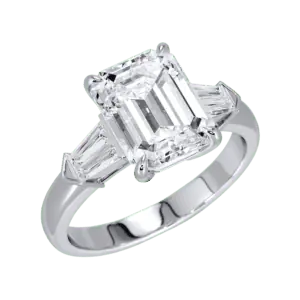
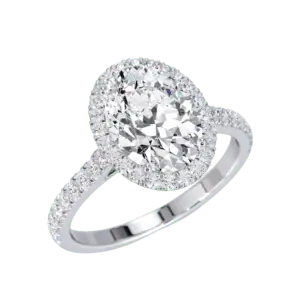
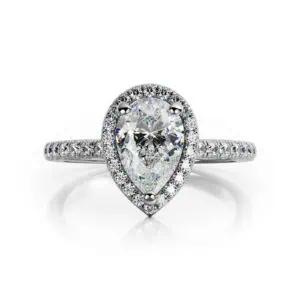
Schedule an appointment with our diamond experts today!
The setting style of your diamond ring plays a significant role in both its aesthetics and functionality. Here’s a breakdown of popular setting styles to help you find the perfect match for your diamond and lifestyle:
The diamond’s shape and size can influence your choice of setting style:
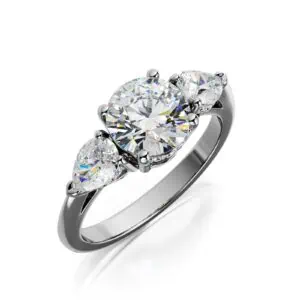
Your lifestyle should also be factored into your setting selection. If you have an active lifestyle or work with your hands frequently, a bezel setting might be the most practical choice due to its superior protection. Prong settings offer a good balance between security and style, while tension settings might require extra care to avoid damaging the diamond.
The width and style of the band can further personalize your diamond ring. Consider a delicate band for a solitaire setting or a slightly thicker band for a halo setting to balance the proportions. Plain bands offer a timeless look, while bands with intricate details like milgrain or engraving can add a touch of vintage charm.
Choosing the perfect diamond ring setting involves a delightful blend of aesthetics, functionality, and personal style. By considering the factors discussed in this blog series, you can confidently select the setting that will beautifully showcase your diamond and complement your unique taste. Remember, our expert gemologists are always happy to guide you through the selection process. Visit our showroom or schedule an appointment today!
White gold offers a modern, sleek appearance with its silvery hue, enhancing the brilliance of diamonds by providing a stark contrast that makes the stones appear whiter and more dazzling. Yellow gold, known for its timeless elegance and warm tone, offers a classic look that adds depth and warmth to diamonds, enhancing their natural fire.
The choice between white gold and yellow gold depends on personal preference and the style you wish to achieve. White gold is excellent for enhancing the brightness of diamonds and suits a contemporary aesthetic, while yellow gold complements warmer skin tones and offers a traditional, luxurious feel.
Yellow gold tends to be more durable and requires less maintenance because it is often purer (less mixed with other metals). White gold, however, is usually alloyed with stronger metals like nickel or palladium, which makes it harder but may require re-plating over time to maintain its color and luster.
The metal color can significantly influence the appearance of colored diamonds. White gold is ideal for colorless and cooler-toned diamonds as it emphasizes their clarity and sparkle. Yellow gold is particularly flattering for diamonds with yellowish hues, as it can intensify the stone’s color and warmth, making it appear more vibrant.
Yes, the choice of metal can affect how large the diamond appears. White gold can often make a diamond appear larger due to its reflective qualities and the way it contrasts with the stone, while yellow gold might enhance the diamond’s color and fire but not necessarily its perceived size.
Brilliant cuts, such as round or princess cuts, tend to sparkle vividly in both white and yellow gold settings. However, certain fancy shapes like emerald or oval cuts might benefit more from the distinct backdrop provided by white gold, which can accentuate their clarity and cut. Conversely, yellow gold may enhance the vintage charm of cushion cuts or other antique styles.
Our newsletter is the perfect mixture between professional good-to-knows and occasional deal & coupons.
Want just one or the other? Join us. You’ll get exactly what you want.
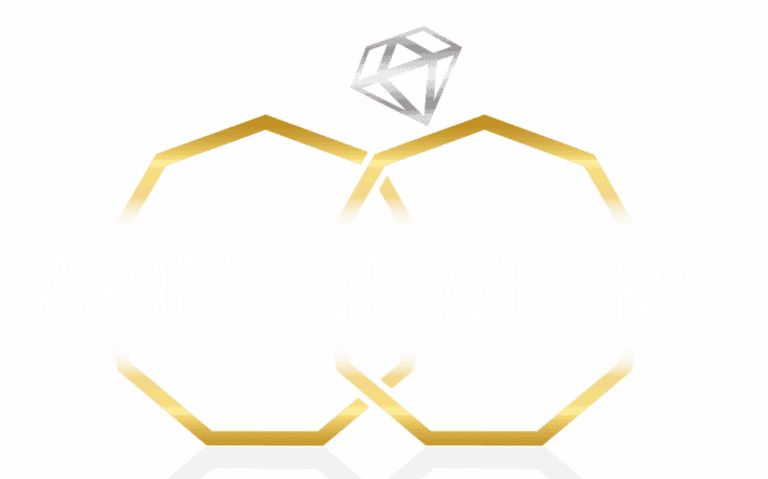
Boutique, family owned, handcrafted Jewelry Design team.
Between quality materials, impeccable design and personal customer service —
We choose all.
We are here for you call US:
+1 (917)-477-8663

If you would like to measure your ring size immediately the quickest ways and with an accurate fit – you can do it with our Ring Size Chart here.
The way to quickly get your measurements is either going to the nearest jewelry shop and ask them to measure you, or to buy a Ring Sizer Measuring Gauge with a 2-day delivery to the US!
Then you can match your measurement to the size chart below to get your exact ring size.
A few factors we recommend to consider for the perfect measure:
Still not sure what your size is or what to choose for your love one? We’re here to help!
| MM | Inches | MM | Inches | UK/AU | US & Canada & Mexico | France | Germany & Russia & Ukraine & Asia | India & China & Japan & South America | Italy & Spain & Netherlands & Switzerland |
| 14.05 | 0.553 | 44.14 | 1.74 | F | 3 | 44 | 14 | 4 | 4 |
| 14.25 | 0.561 | 44.77 | 1.76 | F 1/2 | 3.25 | 44.625 | 14.25 | 4.5 | 4.625 |
| 14.45 | 0.569 | 45.4 | 1.79 | G | 3.5 | 45.25 | 14.5 | 5 | 5.25 |
| 14.65 | 0.577 | 46.02 | 1.81 | H | 3.75 | 45.875 | 14.75 | 6 | 5.875 |
| 14.86 | 0.585 | 46.68 | 1.84 | H 1/2 | 4 | 46.5 | 15 | 7 | 6.5 |
| 15.04 | 0.592 | 47.25 | 1.86 | I | 4.25 | 47.125 | 15.25 | 7.5 | 7.125 |
| 15.27 | 0.601 | 47.97 | 1.89 | I 1/2 | 4.5 | 47.75 | 15.5 | 8 | 7.75 |
| 15.53 | 0.611 | 48.79 | 1.92 | J 1/4 | 4.75 | 48.375 | — | 8.5 | 8.375 |
| 15.7 | 0.618 | 49.32 | 1.94 | J 1/2 | 5 | 49 | 15.75 | 9 | 9 |
| 15.9 | 0.626 | 49.95 | 1.97 | K 1/4 | 5.25 | 49.625 | 16 | 9.5 | 9.625 |
| 16.1 | 0.634 | 50.58 | 1.99 | L | 5.5 | 50.25 | 16.25 | 10 | 10.25 |
| 16.3 | 0.642 | 51.21 | 2.02 | L 1/4 | 5.75 | 50.875 | — | 11 | 10.875 |
| 16.51 | 0.65 | 51.87 | 2.04 | M | 6 | 51.5 | 16.5 | 12 | 11.5 |
| 16.71 | 0.658 | 52.5 | 2.07 | M 1/2 | 6.25 | 52.125 | 16.75 | 12.5 | 12.125 |
| 16.92 | 0.666 | 53.16 | 2.09 | N | 6.5 | 52.75 | 17 | 13 | 12.75 |
| 17.13 | 0.674 | 53.82 | 2.12 | N 1/2 | 6.75 | 53.375 | — | 13.5 | 13.375 |
| 17.35 | 0.683 | 54.51 | 2.15 | O | 7 | 54 | 17.25 | 14 | 14 |
| 17.45 | 0.687 | 54.82 | 2.16 | O 1/2 | 7.25 | 54.625 | 17.5 | 14.5 | 14.625 |
| 17.75 | 0.699 | 55.76 | 2.2 | P | 7.5 | 55.25 | 17.75 | 15 | 15.25 |
| 17.97 | 0.707 | 56.45 | 2.22 | P 1/2 | 7.75 | 55.875 | — | 15.5 | 15.875 |
| 18.19 | 0.716 | 57.15 | 2.25 | Q | 8 | 56.5 | 18 | 16 | 16.5 |
| 18.35 | 0.722 | 57.65 | 2.27 | Q 1/2 | 8.25 | 57.125 | 18.25 | 16.5 | 17.25 |
| 18.53 | 0.729 | 58.21 | 2.29 | Q 3/4 | 8.5 | 57.75 | 18.5 | 17 | 17.75 |
| 18.69 | 0.736 | 58.72 | 2.31 | R 1/4 | 8.75 | 58.375 | 18.75 | 17.5 | 18.375 |
| 18.89 | 0.748 | 59.34 | 2.35 | R 3/4 | 9 | 59 | 19 | 18 | 19 |
| 19.22 | 0.757 | 60.38 | 2.38 | S 1/4 | 9.25 | 59.625 | 19.25 | 18.5 | 19.625 |
| 19.41 | 0.764 | 60.98 | 2.4 | S 3/4 | 9.5 | 60.25 | 19.5 | 19 | 20.25 |
| 19.62 | 0.772 | 61.64 | 2.43 | T 1/4 | 9.75 | 60.875 | 19.75 | 19.5 | 20.875 |
| 19.84 | 0.781 | 62.33 | 2.45 | T 1/2 | 10 | 61.5 | 20 | 20 | 21.25 |
| 20.02 | 0.788 | 62.89 | 2.48 | U | 10.25 | 62.125 | 20.25 | 21 | 22.125 |
| 20.2 | 0.797 | 63.46 | 2.5 | U 1/2 | 10.5 | 62.75 | 20.5 | 22 | 22.75 |
| 20.44 | 0.805 | 64.21 | 2.53 | V 1/4 | 10.75 | 63.375 | — | 22.5 | 23.375 |
| 20.68 | 0.814 | 64.97 | 2.56 | V 1/2 | 11 | 64 | 20.75 | 23 | 24 |
| 20.85 | 0.821 | 65.5 | 2.58 | W 1/4 | 11.25 | 64.625 | — | 23.5 | 24.625 |
| 21.08 | 0.83 | 66.22 | 2.61 | W 3/4 | 11.5 | 65.25 | 21 | 24 | 25.25 |
| 21.24 | 0.836 | 66.73 | 2.63 | X 1/4 | 11.75 | 65.875 | — | 24.5 | 25.875 |
| 21.49 | 0.846 | 67.51 | 2.66 | Y | 12 | 66.5 | 21.25 | 25 | 26.5 |
| 21.69 | 0.854 | 68.14 | 2.68 | Y 1/2 | 12.25 | 67.125 | 21.5 | 25.5 | 27.125 |
| 21.89 | 0.862 | 68.77 | 2.71 | Z | 12.5 | 67.75 | 21.75 | 26 | 27.75 |
| 22.1 | 0.87 | 69.43 | 2.73 | Z +1/2 | 12.75 | 68.375 | — | 26.5 | 28.375 |
| 22.2 | 0.75 | 70 | 2.74 | Z+1 | 13 | 69 | 22 | 27 | 29 |
Simply enter LAUNCH10 at checkout to redeem your discount. Don’t miss out on this limited time offer!